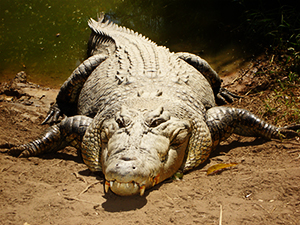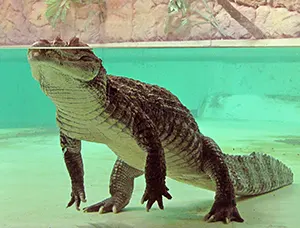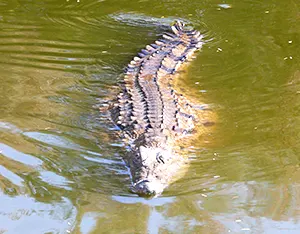How Does a Crocodile Move?

Contents
How a Crocodile Moves
Crocodiles are nature’s ultimate amphibious predators, effortlessly navigating both land and water with six distinct movement styles: swimming, belly-crawling, high-walking, galloping, floating, and diving.
In water, they swim silently at speeds of up to 32 kph (20 mph) using their powerful tails for propulsion. On land crocodiles appear slow and clumsy, often belly-crawling from place to place. However, crocodiles and alligators can trot, gallop, and bound at speeds of up to 18kph (11mph) for very short distances. Explore how these reptiles navigate their world!
The Crocodile's Belly Crawl
The belly crawl is the crocodile's most common movement on land. In this motion, its legs are sprawled out to the sides with feet pointing outward and away from its body. There are several variations to the belly crawl.

Photo: Crocodile belly-crawling
• Slow Belly Crawl: The crocodile's body is relatively rigid and it moves by sliding its chest, stomach, and tail along the ground while diagonally shifting its legs. That is, the right front and left rear legs are lifted and moved forward while the front right and rear left legs, already on the ground, push backwards, propelling the crocodile's body forward. Then the process is repeated with the alternate set of legs. Depending on the surface, a crocodile can reach speeds of 5 to 10 kph using this technique.
• Fast Belly Crawl: As its speed increases, the crocodile almost lifts its body off the ground undulating its body from side to side, and swishing its tail with each stride. Crocodiles often use the higher speed belly crawl to escape potential threats, usually into a body of water It can reach speeds of 5 to 10 kph.
Crocodile High Walking
When high-walking, the crocodile lifts its entire body and nearly half its tail off the ground by positioning its legs erect beneath its body and rotating its feet to face forward, instead of outward. It can travel at speeds of between 2-4kph in this way, with short bursts of up to 5kph.
Crocodile Running (Galloping)
Despite their bulky appearance, crocodiles can gallop at speeds of up to 17 kph (11 mph), while alligators can reach 18 kph (11 mph). However, they can only maintain this speed for short distances (less than 100 meters) before tiring.
Their running motion resembles that of a horse, where they push off with their hind legs and land on their front limbs before repeating the cycle. A running crocodile is a terrifying sight indeed.
How a Crocodile Swims
Crocodiles are well designed for swimming, where their movement appears graceful and effortless. In water, crocodiles use their tails as powerful engines, swinging their tails from side to side with wave-like motions to propel themselves.
• Swimming Speed: Crocodiles can swim at speeds of up to 32 kph (20mph)
in short bursts, which is about three times faster than an average human swimmer.
• Steering: At slow speeds, crocodiles use their limbs for balance and steering. At higher speeds, they tuck their limbs in and use their heads as rudders.
Crocodile Floating
A crocodile’s position in water (above the water, below the water, or underwater) depends on the amount of air in its lungs. By varying the volume of air in its lungs, the crocodile can control its buoyancy. For example, if a crocodile wishes to dive, it exhales air from its lungs, causing its body to sink in the water. The classic crocodilian pose in the water is the 'float' which can take two forms; the horizontal or vertical float.
Horizontal Float

Photo: Crocodile horizontal floating
In the horizontal float position, the crocodile stays motionless on the water's surface, with a portion of its upper body floating above the surface of the water. While in this position, the crocodile splays out its legs to act as stabilisers to prevent it from rolling. Slight adjustments are made by using its legs, especially its webbed hind legs. It may also wag its tail gently to maintain its position in flowing water.
Vertical Float

Photo: Crocodile vertical floating
In the vertical position, the crocodile will only have its head above the water. It will either stand or float underwater to achieve this position. With its head above the water, it can see, smell and hear what's happening around it while being less visible to its potential prey.
Crocodile Diving & Submersion

Photo: Crocodile swim/walking underwater
When a crocodile or alligator wishes to submerge, it exhales air from its lungs to reduce its buoyancy, moves its limb in an upward motion, and slides underwater, with barely a ripple. Once below the surface, the crocodile swims or walks underwater. The crocodile can hold its breath for as long as one hour.


